Although Jeep vehicles are now a Chrysler trademark, the word "Jeep" has slipped into our everyday vocabulary. When spoken, it creates an image that everyone understands. Much has been written on the origins of the vehicle we now know as the Jeep. How it actually came to earn the name "Jeep," and the other vehicles that for a time carried the same name, is a fascinating tale. Legal controversy over the rights to Jeep raged through the 1940s ... and the fallout continues even today. But in the end, overwhelming public opinion was probably the deciding factor, and the truck - a 1/4ton General Purpose 4x4became forever the Jeep. But it wasn't always so.
The first coinage of the word "Jeep," as applied to a motor vehicle, occurred during WWI. According to Major E.P. Hogan, who wrote a history of the development of the Jeep for the Army's Ouartermaster Review in 1941, the word predated the controversy. "Jeep," he wrote, "is an old Army greasemonkey term that dates back to the last war (World War 1) and was used by shop mechanics in referring to any new motor vehicle received for a test." The word also found use in those days as a lessthancomplimentary term for new recruits. Jeep was still used in Army motor pools well into the 1930s when the next incarnation appeared and became the inspiration for many more Jeeps. On March 16, 1936, a comic strip character appeared that became an instant popular sensation. On that day, Eugene the Jeep was introduced to the already beloved Popeye comic strip by E.C. Segar. For those of us too young to have known Eugene well, he was described as being about the size of a dog, though he walked on his hind legs, and was a native of Africa. He subsisted on orchids and was said to be able to cross into the fourth dimension. He solved all sorts of complex problems for Popeye and Olive Oil, and always told the truth. The general public became so enamoured of Eugene the Jeep that his name quickly entered the slang vocabulary of the day. An average comment on an extremely capable person or thing might be, "Hey, he's a real Jeep!"
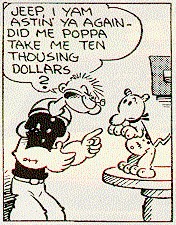
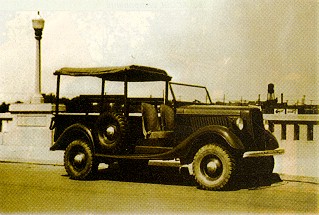
Next comes the Jeep that was never called a "Jeep" but was later regarded as the "Granddaddy" of all Jeeps. Since 1932, the MarmonHerrington Company had built a reputation for its 4x4 conversions of 1 1/2ton (and larger) trucks. In July 1936, because of an obvious military need and a request from the Belgian Government, MH focused on crossing the yetuntried waters of the light 4x4 truck market. They converted a V8powered 1/2ton Ford truck by installing a driving front axle and transfer case. With this conversion, the era of the lightduty 4x4 truck began. The prototype has been widely referred to as the "Darling" but the MH employees who were there remember no such nickname. It isn't clear exactly why the MarmonHerrington truck was never nicknamed "Jeep." (Eugene had been around for a few months, but perhaps the MH engineers never read the comics.)
Later in 1936, Eugene's popularity was highlighted when the Halliburton Oil Well Cementing Company used the name "Jeep" for a custombuilt exploration/survey vehicle. Built by the FWD Corporation to Halliburton specs, the truck was a converted 1935 or '36 model. Like all FWDs, it was an allterrain rig but differed from the standard cargo truck by having a vantype body. The truck had "Jeep" painted on both sides and was once used in advertising. King Features Syndicate, which owned the copyrights to Popeye and Eugene, probably took exception Halliburton soon discontinued official use of the name.They did, however, exhibit a vehicle at the International Petroleum Exhibition in Tulsa, Oklahoma, in 1938, that had an animal caricature painted on the side that looked suspiciously like Eugene. It was in fact a coati, a raccoonlike South American jungle creature. It may have been Halliburton's way of good naturedly thumbing its nose at King Features.
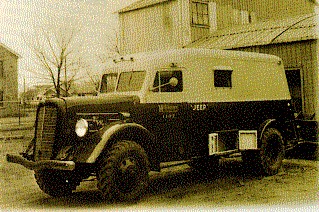
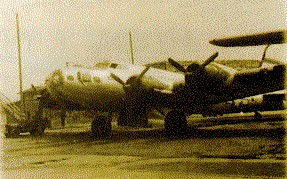
This brings us to 1937 and another Jeep. According to test pilot Col. G.F. Johnson, U.S. Army Air Corps, the prototype YB17 bomber was nicknamed "Jeep" because of its sterling performance. The YB 17 was the predecessor to the heralded Boeing B17 "Flying Fortress" bomber of World War II. This name eventually fell into disfavour because Eugene the Jeep was a little critter and the YB 17 was big by comparison. Gen. H.F. Gregory, the Army Air Corps' first helicopter pilot, said the Jeep name was used for another, smaller, aircraft, with the official of Popeye's publisher. Had this experimental autogyro, a predecessor to the helicopter, gone into production, it would have officially worn the name "Jeep". While testing these amazing Kellett autogyros at WrightPatterson Airfield in Ohio in the late 1930s, Gregory and his fellow test pilots were called "The Jeep Salesmen."
The next version of the Jeep takes us to Camp Ripley, Minnesota, home of the 109th Ordnance Company, Minnesota National Guard. Captain Martin Schiska commanded the 109th, as well as being an employee of the MinneapolisMoline Power Implement Company, builder of farm tractors. In the mid1930s, the Army was still using ancient, hulking 1917 Holt 5ton tractors to pull its larger field pieces. Schiska, a World War I veteran, realized the need for new equipment and impressed this upon MinneapolisMoline. As early as 1938 (some sources say 1937) MM was building and testing prototype prime movers, and in August of 1940, during testing at Camp Ripley, Sergeant James T. O'Brien is quoted by several sources to have applied the name "Jeep" to the MM prime mover. In a letter to MinneapolisMoline dated March 31, 1943, O'Brien explained how the name came about. "One evening," he wrote, "in a gathering of enlisted men, it was suggested that a short descriptive name be found for these vehicles, such names as 'alligator' and 'swamp rabbit.' I brought forth the name 'Jeep' as a result of reading Popeye in which Eugene the Jeep appears as a character, and the fact that these vehicles would go where you would least expect them to go. The name was unanimously accepted and subsequently painted on the vehicles, which have since become familiarly known." The MM Model UTX was a real piece of hardware. Basically a converted farm tractor, the MM Jeep featured fourwheel drive and a 425cid, 70hp (at 1,275 rpm) sixcylinder gasoline engine. It could pull a 5ton 155mm howitzer at 28 mph, with occasional spurts up to 40 mph, and had a fording depth of over three feet. The MM Jeep prototypes came in open and closedcab models. Two of the four tested at Camp Ripley mounted .30cal machine guns. All models featured a roller device in place of a front bumper, enabling it to cross large obstacles. Some also mounted winches. During testing at the Fourth Army maneuvers in August 1940, the MM Jeep was photographed climbing six feet up an oak tree. (The tree gave up at that point, and the tractor crushed it into matchsticks. So much for Treading Lightly!) The tractor was also said to have "walked" through a forest of 5inch trees. These photos appeared in the Army Times (Sept. 14, 1940) in an article entitled "Army Likes Jeep." The MM Jeep performed well in a succession of tests, but the Army's requirements seemed to change by the day. Before the UTX ever went into production, the evolution towards larger and larger field pieces and the requirement for a relatively high road speed ultimately overwhelmed the UTX's capacities. A total of six were built, and one survivesin a private collection.
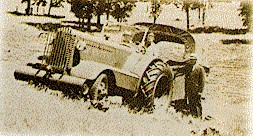
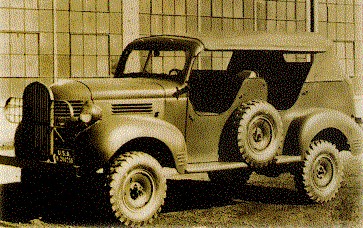
Even though the UTX never saw service, once the proper niche was found, more than a thousand upgraded units were eventually produced in several versions that included a 6x6. MM designs saw service with all branches of the military during World War II and after. Ironically, the Molines found their ultimate niche as aircraft tractors, but even as late as 1943 newspaper headlines still referred to them as Jeeps. "Jeep Helps Save Lives of War Heroes" was the headline of one '43 news story, describing a photo of a MinneapolisMoline NTX tractor and a tale of strafed, burning aircraft being towed off a runway so a group of outof fuel fighters could land.
In 1940, several more "Jeeps"emerged. In the fall of 1939 and spring of 1940, Army units were issued a series of new vehicles that became popular with the troops. The T202 and T207 Dodge 1/2ton 4x4 trucks came in several configurations. The Command Car version, officially designated C&R (Command and Reconnaissance), was the opentopped fourby that was most often called a Jeep. The same basic chassis also came in Pickup, Weapons Carrier, and Carryall body styles. These trucks proved to be very good performers, and it wasn't long before GIs all over began to refer to the common Dodges as "Jeeps" for the same reasons as the MM. This name stuck through the evolution of the 1/2ton Dodge until it was replaced by the more commonly known 3/4tons in mid '42. As late as 1943, some troops were still calling the Dodges "Jeeps." The later Dodges began to be known more or less officially as "Beeps," short for "Big Jeeps."
On 1940, about the same time the Dodges were earning their sterling reputation, the American Bantam Car Company introduced a prototype 4x4 vehicle for testing by the Army at Camp Holabird, Maryland. As early as 1932, the Army had been looking to replace the motorcycle in reconnaissance work. American Austin, which later became American Bantam, supplied the Army with a small pickup version of its 4x2 Austin car for testing as a recon vehicle. It weighed less than half a ton, had oversize balloon tires, and got 40 mpg. It was based on vehicles supplied by the British arm of Austin to that country's military. In 1938, Bantam supplied the Army three more modified versions of its tiny 4x2 Austin roadsters for testing. The Army was generally favourable, but the tests brought out the shortcomings of twowheel drive vehicles in crosscountry use. The new 4x4 specification came out of these tests. Bantam worked closely with the Army to flesh out a design concept for a new vehicle.
To Bantam's surprise, open bids were taken for the new design. The Ordnance Technical Committee sent out specifications to 135 auto manufacturers on July 11, 1940, requiring 70 prototype vehicles to be delivered within 75 days in order to qualify for competition. The specifications and blueprints sent out were essentially those which Bantam developed in June 1940. Only Bantam and WillysOverland responded initially, though Ford was courted because of its large production capability.
Bantam delivered its prototype on September 23, 1940, Willys on November 13, and Ford on November 23. The three test vehicles each sported a manufacturer inspired nickname. The Bantam's was "Bantam" or "BRC" (for Bantam Reconnaissance Car), the Willys' was "Quad,"and the Ford's was "Pygmy." The rigs were extensively tested, and 1,500 improved models were ordered from each manufacturer for more serious evaluation. These were tested in the field with actual Army units; many were sent overseas under Lend-Lease.
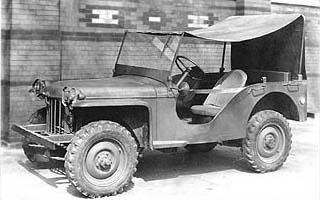
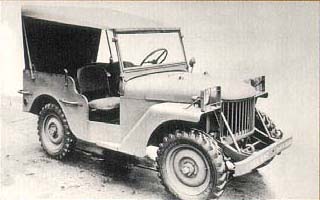
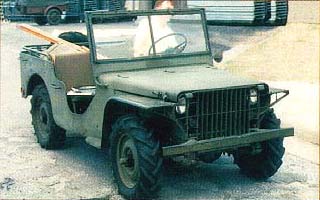
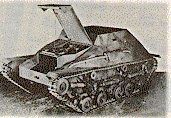
Competition over the potentially lucrative Army contract got extremely fierce, and Henry Ford was said to have exerted every means of influence at his disposal in an attempt to get the contract, though the Willys proved to have the most suitable overall design. In July 1941, after a great deal of turmoil with Ford, Bantam and the Army Quartermaster Corps, the contract was finally issued to Willys-Overland for the new vehicle. Officially designated a 1/4ton Command Reconnaissance truck, production began in earnest and Army units began to see them arrive en masse in late 1941 and early '42. According to a number of Army sources, the nickname most GIs chose for the little Willys fourby was "Peep" (the 1/2ton Dodges remained "Jeeps"). When the first units left overseas, these terms of endearment stayed with them for some time, but it wasn't long before a tide of change overwhelmed everything. By this time there was a huge influx of GIs going into service, many of whom had been subjected to a veritable media blitz about the new 1/4ton 4x4, which the press insisted on calling a "Jeep".
According to Irving "Red" Hausmann, chief test driver for Willys, all this came about through his efforts. Hausmann claimed that as early as 1940, he had overheard a few GIs at Camp Holabird referring to the Willys prototype as a Jeep. There were also a large number of other names floating about, including Peep, Bug, Puddle Jumper, Midget, Pygmy, Leapin' Lena and Blitz Buggy. Apparently, Red liked "Jeep" best, and chose to call the Willys by that name whenever asked. It all came to a head in February 1941, in Washington, D.C. Hausmann was doing a publicity drive up the steps of the Capitol Building in an early production Willys. A bystander asked him, "What is that thing?" Hausmann replied, "It's a Jeep." Reporter Katherine Hillyer of the Washington Daily News overheard the remark and reported the incident in a feature story. From that moment on, the name Jeep stuck like glue.
During the war, even the Navy got onto the Jeep act. When they started building small escort aircraft carriers for convoy protection in '42, they were soon nicknamed "Jeep Carriers." Even up to then, the Navy hadn't been completely Jeepless. Starting in early '42, they bought large quantities of MinneapolisMoline NTX aircraft tractors, which were still being called Jeeps by many troops, as was familiar Willys.
Over the years, much ado has been made over the name Jeep having been derived from its military nomenclature, GP, for General Purpose. This can be disproved easily by noting that until mid1942, the Army designation for the truck was command reconnaissance, not general purpose (that would come later). No doubt the demise of the 1/2ton Dodge Jeep as standard equipment contributed to the use also. When Willys began using the term "Jeep" in advertising, MinneapolisMoline balked. In June 1942, the House Committee on Military Affairs substantiated MM's claim to the name, citing numerous references in newspapers and magazines dating back to before 1940.
In 1943, Bantam joined MM in taking exception to Willys' use of the term. Bantam, having developed the platform from which the other 1/4ton vehicles were based, felt seriouslycompromised by having been left out of the Jeep building business and relegated to making trailers and aircraft landing gear.
In 1944, the Federal Trade Commission chastised Willys over the use of "Jeep"; the turmoil lasted well into the 1950s. But was to no availthe public had spoken. A Jeep was a Jeep and would forever remain a Jeep. While there is no doubt that Willys-Overland was cheeky, perhaps even unethical, in its use of the name, the 640,000 vehicles produced during the war and the many thousands built later certainly earned the right to carry it.
